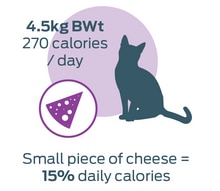
Meet SOPHIE
A 5-year-old, spayed-female, mixed-breed cat
- Sophie is in hospital today for a routine wellness examination. Her body condition score is 5/9, which is consistent with previous visits.
- Although Sophie has always been healthy, her owner is concerned about Sophie’s risk for lower urinary tract disease.
- Sophie is an indoor-only cat that eats mostly dry cat food, although she receives occasional treats of canned food.

Indoor Cats
Feeding Indoor Cats
Indoor cats are at an increased risk of becoming overweight or obese and also having lower urinary tract issues. Hairball management may be another consideration for owners of indoor cats. Indoor cats can benefit from nutrition tailored to their unique needs.
Key Messages
- Indoor cats are typically less active and thus require fewer calories. Feeding guidelines on pet food labels are for an "average" cat, but every cat is an individual.
- If a pet gains or loses weight, the amount of food should be adjusted.
- Treats should not exceed 10% of the daily caloric intake.
- The quantity of food should be reduced when feeding treats since they can contain a surprising amount of calories.

- To minimize the risk of indoor cats eating from boredom, environmental enrichment can help.
- Environmental enrichment, such as puzzle feeders, feather toys, scratching posts, and perches, offers mental stimulation and helps manage weight by encouraging activity.
- Feeding diets containing fibers such as cellulose and soybean hulls can help minimize hairballs.


Related Tools and Content:
Feline Lower Urinary Tract Health: The Role of Diet
Nutrition plays a role in the maintenance of feline lower urinary tract health.
The Purina Body Condition System
The Purina Body Condition System is an easy and practical tool for assessing a pet's body composition.
How to Perform a Body Condition Assessment - Cat
Assess a cat's Body Condition Score in just 3 simple steps.
To Share With Pet Owner:
Benefits of Healthy Weight
Although there are many benefits to maintaining a healthy weight in pets, many owners do not understand what a healthy weight is or the benefits for pets.
Evaluating Your Cat’s Body Condition
Assess your cat's Body Condition in just 3 simple steps.
Additional Resources
AAFCO. (2012). Reading labels. http://talkspetfood.aafco.org/readinglabels [Accessed 28 July 2020]
FEDIAF. Understanding pet food labels. http://www.fediaf.org/39-prepared-pet-foods/80-understanding-labels.html [Accessed 28 July 2020]
Laflamme, D. P. (2006). Understanding and managing obesity in dogs and cats. Veterinary Clinics of North America: Small Animal Practice, 36, 1283–1295.